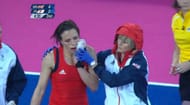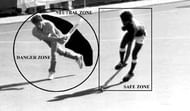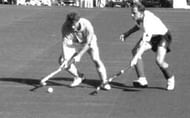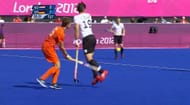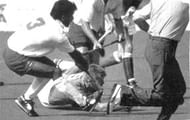Five hockey players were grievously injured during the recently concluded London Olympic Games, while they were tackling from the left.
History has a habit – good or bad – of repeating itself. We often pay more attention, when bad history has repeated itself. Questioning ourselves, how did it happen again? Why did we not learn from our past mistakes?
What can we do now, to prevent them from happening again?
The simple answer is to educate our players and coaches, about how to tackle from the left. Below is a list of 5 serious injuries.
Women’s final match Holland vs. Argentina:
Injury # 1: Argentina’s Right half, Mariela Scarone got hit very badly, while tackling the Dutch Left winger, Ellen Hogg, from the left. The stick missed her left eye by inches.
Women’s semi final match; Holland vs. New Zealand:
Injury # 2: New Zealand’s powerful Center forward Kathy Glyn, got hit on the left side of her head, while fishing for the ball between the legs of the Dutch forward Carlen Heuvel, who was in the process of taking a shot on the goal. The scene was like some one smashing your head with a sledge hammer.
Men’s classifications match South Africa vs. India:
Injury # 3: South Africa’s right winger Norris Jones, was in the process of crossing the ball in the 3rd minute of the game, when India’s Left half Manpreet Singh tackled him from the left and got badly hurt on the left side of his head.
Women’s Pool match Great Britain vs. Japan:
Injury # 4: Great Britain’s captain Kate Walsh fractured her jaw, while tackling the Japanese Right winger from the left, who was in the process of crossing the ball. To her credit – like the above named players – played bravely with a bracelet for the remaining of the tournament and a bronze medal in the process.
Men’s Pool match Korea vs. India:
Injury # 5: Korea’s defender Jong Bok Cha got hurt on the face, while tackling India’s forward Tushar Khandkar, who was in the process of taking a shot on the goal.
 All these injuries could have been easily avoided, if the players knew – and were taught by their respective coaches – how to tackle from the left safely. Ignorance is no excuse in law and the game of hockey, especially, when it is being played at the pinnacle of all hockey tournaments – Olympic Games. At the same time it is very sad, indeed.
All these injuries could have been easily avoided, if the players knew – and were taught by their respective coaches – how to tackle from the left safely. Ignorance is no excuse in law and the game of hockey, especially, when it is being played at the pinnacle of all hockey tournaments – Olympic Games. At the same time it is very sad, indeed.
Purpose of this article:
- Educate our coaches and athletes … How to and Why?
- Develop awareness
- Recognize potentially dangerous situations instantly
- Avoid injuries, at all costs
No win situation:
When a opponent is in the process of hitting the ball, and the tackler is forced to make a tackle, from the left, or for that matter from different awkward angles and positions, one should approach with caution, from the left. And be clear about what are one’s objectives, which should be in this order, depending upon a specific game scenario.
- Safety first
- Delay and distract the opponent – buy time, so team mates can settle and cover
- If one gets the ball … excellent
The chances of the tackler getting the ball are minimal, except for the very few tacklers, who are shrewd and cunning and can easily steal the ball, just as they can pull the tooth from a lion’s mouth. Usually the tackler is in a ‘no win’ situation.
What should the tackler aim for?
The whole aim of the tackler should be to put pressure and force on the player with the ball so as to rush him into making a bad pass or shot on goal in certain game scenarios. So the pass may be intercepted and a counter attack is launched. If the tackler steals the ball it is an added bonus. Another strategy for the tackler can be, to delay the player with the ball as much as possible, so the teammates can settle and cover all angles.
Please remember this Golden rule:
The tackler should never ever be caught in a position where he is vulnerable to injury. This occurs when he is caught in a no man’s land — neither too near nor too far from the swing range — of the hitter. It is a dangerous zone.
Netherlands vs. India, 1988 Seoul Olympic Games
Indian forward is smartly tackling from the left. He is out of the danger zone and is floating in the safe zone.
German forward Christopher Zeller is creeping into the danger zone to put pressure with caution, on Dutch defender Sander de Wijn. Please observe how alert and sharp Christopher is.
How to tackle from the left:
Step 1: Hold the stick in the left hand only.
Step 2: Never get caught in a no man’s land — danger zone — when the opponent is in the process of hitting the ball and has taken the back swing.
Argentina’s Right half, Mariela Scarone, is caught in the no man’s land, while tackling the Dutch left winger, Ellen Hogg, who is in the process of crossing the ball, while taking a back swing.
The above pic depicts the moment when Mariela Scarone was being hit on the face, just inches below her left eye, by the follow through of the swing.
The above pic depicts the moment when Kathy Glyn and captain Kayler Sharland, are caught in the no man’s land, while Dutch forward Carlen Heuvel, is taking a shot on the goal. And both are hit with one swing.
Step 3: Try to hop into the no man’s land — danger zone — when the hitter is in the process of receiving, controlling or dribbling the ball.
Netherlands vs. Great Britain, 1996 Olympic Qualifier, Spain
Dutch defender is in process of controlling the ball; GB forward, Rob Thompson, has jumped into the Danger zone to exert pressure. Please observe Rob’s body position. If the Dutch player decides to hit the ball quickly, Rob can hop into the neutral zone and protect himself.
Step 4: As soon as one sees that the opponent is going to hit the ball, hop into the neutral zone or step back into the safe zone.
Step 5: Put pressure. Employing cat and mouse tactics depending upon the situation.
Step 6: Never Ever stay in the danger zone when the hitter has taken the back swing to hit the ball.
Step 7: The most important thing to do is, hop closer and bring your body very close to the back of the hitter. The whole body — including legs and arms — must be behind the hitter’s back. One’s head and face covered and protected behind the hitter’s head.
 Argentina’s Rosario Luchetti is demonstrating a safe way to tackle, while being in the neutral zone, and protecting herself – especially her head and face, being so close to USA captain Rachel Dawson. It appears that she was also able to steal the ball from US captain, Rachel Dawson, with her reverse stick.
Argentina’s Rosario Luchetti is demonstrating a safe way to tackle, while being in the neutral zone, and protecting herself – especially her head and face, being so close to USA captain Rachel Dawson. It appears that she was also able to steal the ball from US captain, Rachel Dawson, with her reverse stick.
Step 8: Just try to peep quickly – from the corner of your eye and see if you can tap the ball away, with the reverse stick, being held in the left hand, while the hitter has taken the back swing. Be aware and super quick
Step 9: If this is not possible, just pressure him to take a quick miss hit.
Step 10: The other option after step 4 is to back peddle out of the no man’s land, staying away from the range of hitters swing, while floating in the safe zone. Some times this is may not be an option, at all.
As we know, it is not easy to tackle from the left, on the other hand it is also, not worth risking one’s personal safety. Wise players don’t take unnecessary risks. Period!
Sports injury:
Sports and injuries are inseparable, though some injuries can be totally avoided by playing smart and taking necessary precautionary measures. In some circumstances they are unavoidable, but the degree of damage can be controlled or minimized by being cautious and playing safe. The most important thing our coaches and players need to know is: how to tackle from the left, and avoid injury at all costs.
Responsibility:
Both coaches and athletes are jointly responsible. From a coaches point of view, we must educate our players, How to Tackle tactfully from the left, in this potentially dangerous situation. From the athlete’s angle, they should be smart enough to recognize the dangerous situation instantly and have the knowledge to make the right decision, and avoid injury at all cost, under hugely difficult and pressure cooker game situations
Conclusion:
If the coaches can bring home this point of safety, our moral obligation to the players has been taken care of, to a certain degree. We should never let the 5 incidents mentioned above, ever happen again.
On a lighter note in the earlier decades, the forwards used to be scared of the deep defenders – as they were hard hitters of the ball and did not hesitate to intimidate them and scare the shit out of them. It looks like now it is pay back time and it is the other way around, as revealed by the above 5 incidents.
One of the scariest moments happened in the 1990 World Cup, Lahore, in the match between Canada and Ireland – it is hard to forget.
Nick Sandhu, the Canadian deep defender had the ball under control, in his circle in front of the goal, and was in the process of hitting it, to clear it.
Irish forward Jimmy Kirkwood, dived low from the left to tackle. Jimmy got badly hit by Nick’s follow through swing. Jimmy’s cheekbone was fractured and needed 15 stitches. The scene was full of blood. This and the above 5injuries need not to happen.
Photo18: The moment Nick’s follow through swing hit Jimmy’s face


